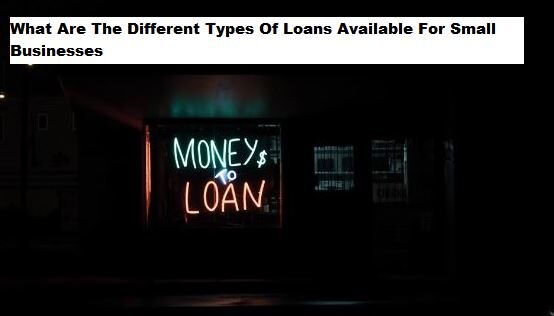What Are The Different Types Of Loans Available For Small Businesses: Starting and growing a small business comes with its challenges. One of the biggest hurdles is securing the necessary funding to get off the ground and thrive. Small businesses often need financial support to cover costs such as equipment, inventory, or even day-to-day operations. But how do business owners secure that funding? There are several options available, each with its own benefits and considerations.
When asking, “What are the different types of loans available for small businesses?” you’ll quickly discover that there’s a wide variety of financial products designed to meet specific needs. Small business loans range from traditional bank loans to specialized loans through government programs, such as the Small Business Administration (SBA). Understanding these options can help business owners make better decisions, whether they are seeking funding for a new business venture or looking to grow an existing one.
In this article, we will break down the various types of loans available to small business owners. We’ll answer some common questions, explain the differences between loan options, and offer insights into what lenders are looking for when approving loans. Whether you’re a first-time entrepreneur or an established business owner, knowing your loan options is essential for financial success.
Also, READ
How Do Student Loans Affect Your Credit Score
What Are The Differences Between Secured And Unsecured Loans?
What Is The Best Personal Loan For Debt Consolidation In 2025?
What Is the Most Common Form of Financing for a Small Business?
When considering “What are the different types of loans available for small businesses?”, it’s important to start with the most common forms of financing. For many small business owners, traditional bank loans are the first option that comes to mind. These loans are provided by banks or credit unions and typically offer competitive interest rates and long repayment terms. However, securing a traditional bank loan can be challenging, especially for new businesses without an established credit history.
Another common option for small businesses is the SBA loan. The Small Business Administration provides government-backed loans to help entrepreneurs access the funding they need. SBA loans are popular because they offer lower interest rates and longer repayment terms compared to other financing options. The most common SBA loan programs are the 7(a) and 504 loans, which are designed to meet the diverse needs of small businesses. These loans are often easier to obtain than traditional bank loans, as they come with the added benefit of a government guarantee that reduces the risk to lenders.
Aside from SBA loans, business owners also turn to lines of credit, merchant cash advances, and microloans, depending on their business needs. A line of credit allows a business to borrow money up to a predetermined limit, offering flexibility for ongoing expenses. Merchant cash advances, while expensive, provide quick access to cash based on future sales, and microloans cater to smaller businesses needing modest funding. Each of these financing options plays a vital role in small business growth.
How Much Do You Have to Put Down on a 7a SBA Loan?

When asking “What are the different types of loans available for small businesses?”, one question many business owners have is about the down payment required for an SBA 7(a) loan. The good news is that SBA 7(a) loans typically have lower down payment requirements compared to traditional bank loans. The exact amount you’ll need to put down depends on the size and type of loan you’re applying for, as well as the lender’s specific requirements.
In most cases, the down payment for a 7(a) loan ranges from 10% to 20% of the total loan amount. For example, if you’re applying for a loan of $500,000, you might be required to put down anywhere between $50,000 and $100,000. This percentage may vary depending on the type of business and the collateral you can offer. In some cases, if the loan is used to purchase real estate or equipment, the down payment might be lower due to the value of the asset acting as collateral.
The SBA guarantees a portion of the loan, which helps reduce the lender’s risk and allows for lower down payment requirements. However, lenders may still have their own guidelines based on your business’s financial health and creditworthiness. Having a solid business plan and demonstrating your ability to repay the loan will increase your chances of securing a loan with a lower down payment.
What Is the Difference Between an SBA 504 and 7A Loan?
When asking “What are the different types of loans available for small businesses?”, many business owners come across the two most popular SBA loan programs: the 504 and 7(a) loans. While both are backed by the Small Business Administration, they have distinct purposes and eligibility requirements.
The SBA 7(a) loan is the most versatile loan option. It can be used for a wide range of business purposes, including working capital, equipment, inventory, and real estate. The SBA 7(a) loan program is ideal for small businesses that need flexible funding for general operating expenses. These loans are generally available for amounts up to $5 million, with repayment terms ranging from 7 to 25 years. The interest rates are typically competitive, and the SBA guarantees a significant portion of the loan to reduce risk for lenders.
In contrast, the SBA 504 loan is specifically designed for businesses looking to finance long-term assets, such as real estate or large equipment. It is ideal for businesses that need to expand or renovate their facilities or purchase heavy machinery. The SBA 504 loan typically requires a larger down payment (around 10%), but the interest rates are often lower than those for a 7(a) loan. SBA 504 loans are available in amounts up to $5 million, with repayment terms ranging from 10 to 20 years.
The key difference between the two lies in their intended purpose. If your business needs capital for everyday expenses or working capital, the 7(a) loan is your best option. However, if you’re looking to make a significant investment in property or equipment, the SBA 504 loan would be more appropriate.
What Is the Easiest SBA Loan to Get?
When considering “What are the different types of loans available for small businesses?”, many entrepreneurs are eager to find out which SBA loan is the easiest to secure. While all SBA loans require thorough documentation and a strong business plan, some are relatively easier to obtain than others.
The SBA 7(a) loan is generally considered the most accessible SBA loan for most businesses. It is widely available, flexible in its usage, and offers relatively low-interest rates. For businesses with strong credit, a solid business plan, and a well-established financial history, the SBA 7(a) loan is typically the best option. The SBA’s guarantee of a portion of the loan helps lenders feel more secure in offering financing to businesses that might not qualify for traditional loans.
Additionally, SBA microloans are another relatively easy financing option for smaller businesses. These loans are typically for amounts under $50,000 and are ideal for businesses that may not qualify for larger SBA loans. The application process for microloans tends to be quicker and less stringent than other SBA loans, making it easier for small businesses to access capital quickly.
To increase your chances of success, it’s crucial to ensure that your credit score, financial statements, and business plans are in order before applying for any SBA loan.
How Hard Is It to Get an SBA 7A Loan?
When answering “What are the different types of loans available for small businesses?”, another important question that comes up is how difficult it is to secure an SBA 7(a) loan. While SBA 7(a) loans offer favorable terms, they do come with specific requirements that can make the application process challenging for some business owners.
The difficulty of obtaining an SBA 7(a) loan depends on a few key factors: credit history, business stability, and the loan amount requested. Lenders typically look for business owners with a strong credit history (usually a FICO score of 650 or higher), a solid business plan, and a track record of revenue and profitability. New businesses or those with limited financial history may find it more challenging to qualify for a 7(a) loan, but not impossible.
Additionally, the loan amount and purpose will influence the approval process. While smaller loans are often easier to obtain, larger loans may require additional documentation, collateral, and time for approval. It’s also important to note that SBA 7(a) loans require a significant amount of paperwork and time for processing. Expect to spend a few weeks or months gathering necessary documentation and waiting for approval.
What Is the Difference Between SBA 15 and SBA 16?
In the context of SBA loans, you may come across terms like SBA 15 and SBA 16. These are not types of loans but are instead forms used by the SBA to track and manage specific aspects of the loan process. SBA Form 15 refers to a “SBA 7(a) Loan Authorization and Agreement,” which is a document outlining the terms and conditions of an SBA loan. SBA Form 16, on the other hand, is a “Small Business Loan Application Checklist” used for SBA loan applications.
Both forms are essential parts of the application process and must be submitted to ensure that the loan meets SBA guidelines. While they may seem like loan types, they are simply part of the documentation required when applying for SBA loans.
What Disqualifies You from Getting an SBA Loan?
When applying for SBA loans, it’s crucial to know what can disqualify you from receiving funding. Common disqualifying factors include poor credit history, insufficient collateral, and failure to meet the SBA’s eligibility requirements. Business owners with a history of bankruptcy or delinquent payments may face challenges in securing SBA loans, as lenders will be hesitant to lend to individuals with a high risk of default.
In addition, businesses that do not meet SBA criteria, such as those involved in illegal activities or speculative ventures, are not eligible for SBA loans. Businesses without sufficient cash flow or those lacking a solid business plan may also struggle to qualify.
It’s essential to address any potential issues with your business before applying for an SBA loan. Working with a financial advisor to improve your credit score or secure necessary documentation can increase your chances of approval.
Conclusion
When asking, “What are the different types of loans available for small businesses?”, it’s clear that there are numerous options to choose from, each designed to meet specific business needs. Whether you’re interested in an SBA loan, a traditional bank loan, or other types of financing, understanding your choices is the first step toward securing the right loan for your business.
Every business is unique, and your financing needs will depend on various factors like your credit score, business history, and the amount of capital you need. By researching and understanding the different loan options, you can find the best fit to fuel your business’s growth and success.






